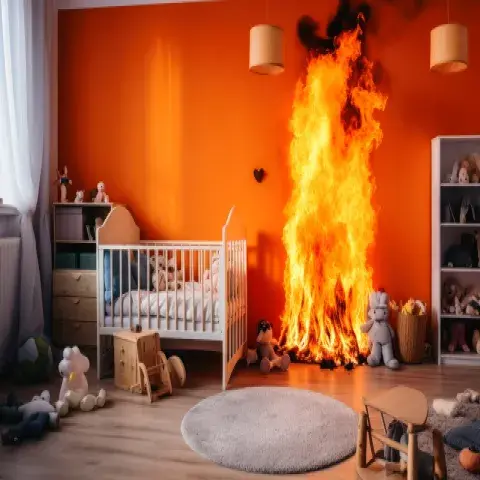Space heaters have become a popular solution for keeping homes warm, especially during the chilly winter months. While they offer convenience and localized heating, it’s crucial to acknowledge the potential dangers associated with their use. Understanding and respecting the risks can help ensure a safe and cozy environment for you and your loved ones. In this blog post, we’ll explore the top dangers of using a space heater and provide tips on how to use them responsibly.
Mitigating the Fire Hazard
Space heaters pose a notable fire hazard due to their heat generation through convection or radiation. Improper use of these devices can lead to the ignition of nearby combustible materials like curtains, furniture, or carpets. To safeguard against such risks, it is crucial to adopt precautionary measures. Always position the space heater on a flat and stable surface, ensuring it maintains a safe distance from flammable objects. These simple steps significantly reduce the potential for fires, enhancing the overall safety of using space heaters.
Safety Measures Checklist:
- Place the space heater on a flat and stable surface.
- Maintain a safe distance from curtains, furniture, and carpets.
- Regularly inspect the heater for any signs of damage or malfunction.
- Avoid using extension cords and plug the heater directly into an outlet.
- Turn off the space heater when leaving the room or going to sleep.
- Keep the surrounding area clear of any combustible materials.
- Install smoke detectors in the vicinity for early fire detection.
- Follow the manufacturer’s guidelines and safety instructions for the specific space heater model.
Prevent Electrical Overload
The use of space heaters demands a careful approach to prevent electrical overload, a significant cause of potential fires. These devices draw a substantial amount of electrical power, and when operated on overloaded circuits, they pose a heightened risk of electrical fires. To safeguard against such hazards, it is essential to verify that your space heater is compatible with your home’s electrical system. Additionally, avoid the use of extension cords or power strips, as these can exacerbate the risk of overheating. For optimal safety, always plug your space heater directly into a wall outlet, ensuring a dedicated and reliable power source.
Safety Measures Checklist:
- Check Compatibility: Ensure your space heater is compatible with your home’s electrical system.
- Avoid Extension Cords: Never plug the space heater into an extension cord or power strip.
- Direct Wall Outlet: Always plug the space heater directly into a wall outlet.
- Inspect Wiring: Regularly inspect the power cord for any signs of damage or wear.
- Dedicated Circuit: Consider using a dedicated circuit for the space heater to avoid overloading shared circuits.
- Follow Manufacturer’s Instructions: Adhere to the manufacturer’s guidelines regarding electrical requirements and usage.
- Unplug when not in use: When the space heater is not in use, unplug it to prevent any potential electrical issues.
- Regular Maintenance: Keep the space heater and its components well-maintained to ensure proper functioning and safety.
Safeguarding Against Carbon Monoxide
Gas-powered or fuel-burning space heaters present a distinct peril by emitting carbon monoxide (CO), an invisible and odorless gas with severe health consequences, including the risk of death when inhaled in large amounts. Prioritizing safety is imperative when using space heaters, and opting for electric models indoors is a crucial measure. Additionally, for those using any type of fuel-burning heater, ensuring proper ventilation is vital to prevent the accumulation of this toxic gas within enclosed spaces.
Safety Measures Checklist:
- Choose Electric Heaters: Opt for electric space heaters for indoor use to eliminate the risk of carbon monoxide emissions.
- Ventilation is Key: When using any fuel-burning heater, ensure proper ventilation to prevent the buildup of carbon monoxide.
- Install CO Detectors: Place carbon monoxide detectors in key areas of your home to provide an early warning in case of gas leaks.
- Regular Inspections: Periodically inspect fuel-burning heaters for leaks, malfunctions, or signs of wear and tear.
- Follow Manufacturer’s Guidelines: Adhere to the manufacturer’s instructions regarding proper usage and maintenance of space heaters.
- Keep Areas Clear: Maintain a clear space around the heater to ensure adequate airflow and prevent overheating.
- Educate Household Members: Inform everyone in the household about the dangers of carbon monoxide and the safety measures in place.
Avoiding Tip-Over Accidents
The compact and portable nature of space heaters introduces a potential hazard—tip-over accidents. The risk of fire or burns increases significantly if a space heater topples over. To mitigate this danger, it is advisable to select a heater equipped with a tip-over switch that automatically shuts off the unit upon being knocked over. Furthermore, strategic placement of the heater in an area less prone to being bumped or tipped is essential to enhance overall safety.
Safety Measures Checklist:
- Choose Tip-Over Switch: Opt for a space heater with a built-in tip-over switch that automatically turns off the unit if it falls.
- Stable Placement: Place the heater on a flat, stable surface to minimize the likelihood of tipping over.
- Secure Cord Placement: Ensure the power cord is safely positioned to avoid tripping hazards that could lead to a tip-over.
- Keep Clear Surroundings: Maintain a clear area around the space heater, free from obstacles or clutter that may cause it to topple.
- Supervise Usage: Avoid leaving a space heater unattended, especially in households with pets or small children.
- Regular Inspections: Periodically inspect the heater for any signs of damage or wear that may compromise its stability.
- Educate Household Members: Inform everyone in the household about the importance of preventing tip-over accidents and the safety features of the space heater in use.
Preventing Burns and Scalds
Operating at high temperatures, space heaters pose a potential risk of burns and scalds if not handled with care. Accidental contact with the hot surfaces can lead to injuries. To mitigate this risk, exercise caution when handling or adjusting the heater, and ensure that flammable items, children, and pets are kept at a safe distance. Choosing heaters with cool-touch exteriors provides an additional layer of protection, significantly minimizing the likelihood of burns.
Conclusion
As we strive for warmth and comfort in the colder months, it’s essential to recognize the potential hazards associated with space heaters and adopt responsible usage practices. From the risk of fires to electrical overloads, carbon monoxide emissions, tip-over accidents, and the possibility of burns and scalds, understanding and addressing these concerns are crucial for a safe and cozy living environment. By implementing the safety measures outlined in this comprehensive guide, you can enjoy the benefits of space heaters while minimizing the associated risks. Prioritize safety, educate household members, and make informed choices to ensure that your winter warmth is accompanied by peace of mind. Stay warm and stay safe!



